 |
 |
 |
 |
|
Night Life in Datong
|
|||||||||||||||||||||||||
| Not much time in Beijing, dinner at our hotel and another visit to the internet cafe down the street. Across from the internet bar and next to the Merry Mart (favorite shopping hangout of many in our group), there is evening sidewalk ballroom dancing. I wander up and down the block; they are playing "Oh Susannah" which has never exactly impressed me as a waltz standard. Next door is a theatre currently showing Pirates of the Caribbean 3. Not sure if this would be dubbed or subtitled, but either way it might be worth checking out if I have a lot of free time back in BJ. Best find: at the end of the block, back on the internet bar side of the street, is a sports store carrying Mingzu shoes, with a prominent display of SYP posters (the most recent ad campaign). Maybe I will buy myself a new pair of sneakers. It's a long drive to Datong but highway all the way. We also got a chance to see several sections of the Great Wall, including Badaling (which has a huge sign on the hillside — yuck!) and Juyongguan. The wall still takes my breath away, every time I see it. Datong has a huge town square with a heroic statue, a massive government building, and a huge TV screen running MTV videos. In the evening, the area fills with young people batting around a feathered hackysack thingie, miniature vehicles for kids to ride, and a variety of food and drink stalls. For several blocks in the direction of our hotel (the largest building around, with an impressive lit sign although there is no entrance on Daxi Jie), street venders have set up food stalls, produce stands, and blankets with every concievable item for sale. Lots of shoes. And underwear. Our local guide Kanga ("no Roo") gave me directions to the best CD store in town; its entrance looks like the opening to a coal mine (I'm not sure why). Unlike most places we visited in southwest China last summer, there has been a dearth of CD/DVD/VCD stores. Even this one has no obvious signage. I go in, walk up the stairs and am immediately targeted by several salesgirls who must be bored to death as there is little store traffic. I ask for Su You Peng CDs, but they reply "mei you"—and still follow me around while I browse. Eventually one of them comes up with a cassette (Aegean Sea-era photo on the front), but no CDs, so I thank them and leave. I had spotted a bookstore way down on the other side of the hotel, but it's closing as I got there. I peeked into the Lanswe store, but was a bit intimidated by the hawk-like stares of more salesgirls, and decided against buying any men's underwear packaged with SYP's photo. The focus of the visit to Datong is the presence of several Buddhist sites. First is the Yuangang Grottoes, a great cave complex with carvings and paintings dating from the Northern Wei dynasty. Some of the caves are still being excavated or reconstructed, but we could walk through almost 20 caves with some very impressive art. |
|||||||||||||||||||||||||
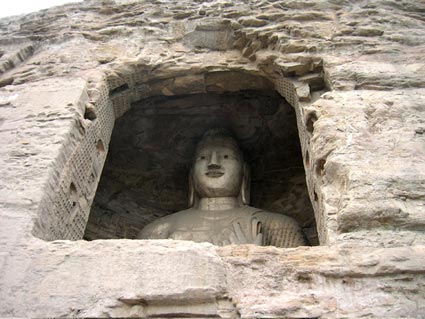 |
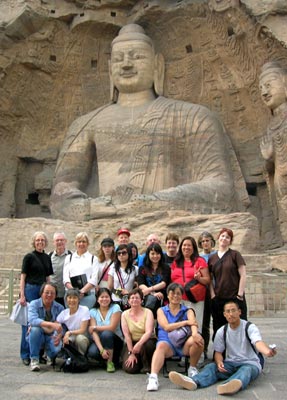 |
||||||||||||||||||||||||
| Back in the hotel, Elizabeth and I decided to have a game of pool. As we were batting the last few balls around the table, Ann came in with a young, professionally dressed Chinese woman, and asked us to chat with her. (Elizabeth is up to Chinese 4 at CCSF.) Zheng Wei is a marketing director at the hotel, and has a little phrase booklet which is probably part of the pre-Olympics English language cram course. We settled into a bar booth and attempted very primitive conversation, mostly in Chinese, including a tentative rendition of "The Moon Represents My Heart." We're all pretty tired, but it's fun, and we exchange cards and email addresses. And then to bed. | 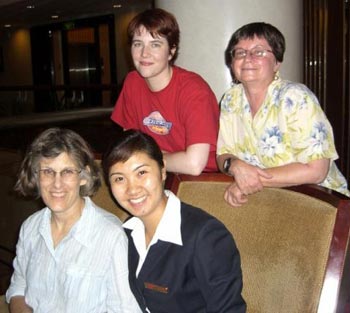 |
||||||||||||||||||||||||
|
Foursome in Datong hotel (photo by Amihan Makayan)
|
|||||||||||||||||||||||||
| The next day we drove out of town to the Hanging Monastery in Yingxian. This reminds me somewhat of the Anastazi dwellings in Mesa Verde (southern Colorado). The monastery was built above a river, which has since receded in level, and the builders had to lower themselves down from above. The monastery incorporates shrines for all three of China's major religions: Buddhism, Daoism and Confucianism. There is a path and walkway to go through most of the existing structures. The architectural decorations are very beautiful, Qing facade added to Northern Wei construction. |
|||||||||||||||||||||||||
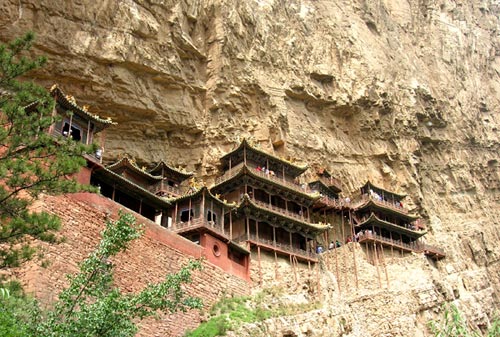 |
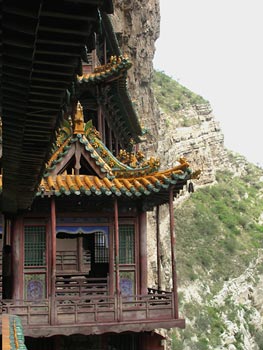 |
||||||||||||||||||||||||
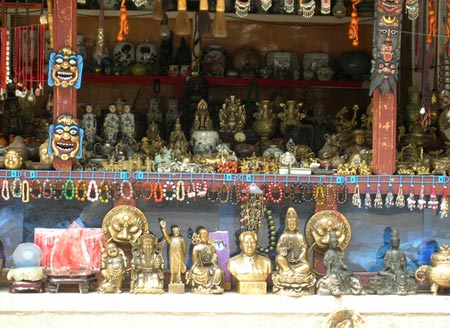 |
Yingxian Hanging Monastery | ||||||||||||||||||||||||
| Buddha (and Mao) shopping in the Hanging Monastery souvenir market | |||||||||||||||||||||||||
| Back in Datong, we visited two of the oldest wooden structures in China, the Huayun and Shanhua Temples, located in the center of town. These date from the Liao Dynasty, with wooden lattice roof structures rather than beam roof supports. The temples are small and very pleasing in design; one is now a museum and the other houses a community of monks. Some Ming structures have been added to the temple grounds, including large protective water dragon sculptures on the roofs, but I still like the feel of an earlier simplicity. (And, of course, there's that YMHJ resonance....) |
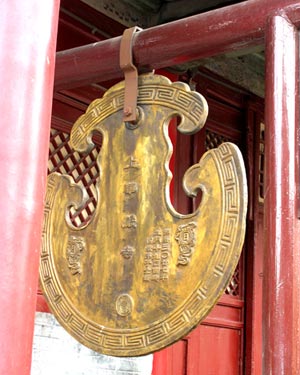 |
||||||||||||||||||||||||
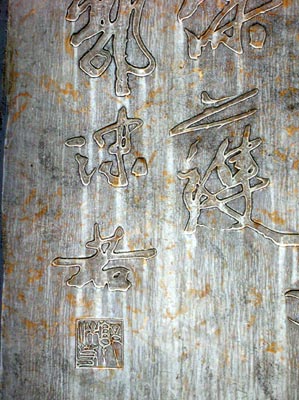 |
|||||||||||||||||||||||||
| Liao era temples, Datong | |||||||||||||||||||||||||